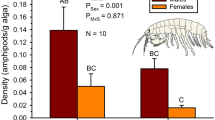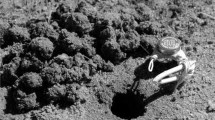Summary
A North American water strider, Gerris remigis (Hemiptera) copulates for prolonged periods of time, apparently beyond the time necessary for insemination (Rubenstein 1984; Wilcox 1984; Clark 1987), I tested predictions from two different hypotheses of the adaptive significance of this behavior. Manipulations of the operational sex ratio in artificial “streams” revealed that water striders copulate significantly longer when the sex ratio is male-biased. This result is consistent with the hypothesis that prolonged copulation functions as a type of contact mate guarding, which reduces sperm competition by preventing the female from remating prior to oviposition. The finding is also consistent with the hypothesis that copulation is prolonged to enhance female foraging efficiency. In a second experiment, sex ratio and total population density were held constant, and the period of food deprivation of females was manipulated. Contrary to the predictions of the female foraging hypothesis, “starved” females did not copulate longer than “fed” females. Of the two hypotheses considered, only the copulatory guarding hypothesis explains both results. This does not mean, however, that there is no selective benefit from the enhanced foraging efficiency resulting from prolonged copulation. Nor does it exclude the possibility that this benefit has been necessary for the evolution of prolonged copulation in water striders.
Similar content being viewed by others
References
Boorman E, Parker GA (1976) Sperm (ejaculate) competition in Drosophila melanogaster, and the reproductive value of females to males in relation to female age and mating status. Ecol Ent 1:145–155
Chapman RF (1982) The insects structure and function (third edition). Harvard University Press, Cambridge
Clark SJ (1986) ESS equations sometimes do not specify an ESS. J Theor Biol 123:325–331
Clark SJ (1987) Prolonged copulation in the water strider Gerris remigis and a model of the evolution of sperm competition avoidance mechanisms. PhD thesis, The Rockefeller University
Dickinson JL (1986) Prolonged mating in the milkweed leaf beetle Labidomera clivicollis (Coleoptera: Chrysomelidae): a test of the “sperm-loading” hypothesis. Behav Ecol Sociobiol 18:331–338
Engelmann F (1970) The physiology of insect reproduction. Pergamon Press, Oxford
Jamieson GS, Scudder GGE (1977) Food consumption in Gerris (Hemiptera). Oecologia 30:23–41
Knowlton N, Greenwell SR (1984) Male sperm competition avoidance mechanisms: The influence of female inerests. In: Smith RL (ed) Sperm competition and the evolution of animal mating systems. Academic Press, Orlando, pp 61–84
Labitte A (1919) Observations sur Rhodocera rhamni. Bull Mus Hist nat, Paris 25:624–625
McLain DK (1980) Female choice and the adaptive significance of prolonged copulation in Nezara viridula (Hemiptera: Pentatomidae). Psyche 87:325–336
Murvosh CM, Fye RL, LaBreque GC (1964) Studies on the mating behaviour of the house fly, Musca Domestica L. Ohio J of Sci 64:264–271
Parker GA (1970) Sperm competition and its evolutionary consequences in the insects. Biol Rev 45:525–567
Parker GA (1970) Courtship persistence and female-guarding as male time-investiment strategies. Behaviour 48:157–184
Rubenstein DI (1984) Resource acquisition and alternative mating strategies in water striders. Am Zool 24:345–353
Siegel S (1956) Nonparametric statistics for the behavioral sciences. McGraw-Hill, New York
Thornhill R (1976) Sexual selection and parental investiment in insects. Am Nat 110:153–163
Thornhill R (1984) Alternative hypotheses for traits believed to have evolved by sperm competition. In: Smith RL (ed) Sperm competition and the evolution of animal mating systems. Academic Press, Orlando, pp 151–178
Thornhill R, Alcock J (1983) The evolution of insect mating systems. Harvard University Press, Cambridge
Trivers RL (1972) Parental investiment and sexual selection. In: Campbell B (ed) Sexual selection and the descent of man 1871–1971. Aldine, Chicago, pp 136–179
Walker WF (1980) Sperm utilization strategies in nonsocial insects. Am Nat 115:780–799
Wilcox RS (1979) Sex discrimination in Gerris remigis: role of a surface wave signal. Science 206:1325–1327
Wilcox RS (1984) Male copulatory guarding enhances female foraging in a water strider. Behav Ecol Sociobiol 15:171–174
Wilcox RS, Ruckdeschel T (1982) Food threshold territoriality foraging in a water strider. Behav Ecol Sociobiol 15:171–174
Wilcox RS, Ruckdeschel T (1982) Food threshold territoriality in a water strider (Gerris remigis). Behav Ecol Sociobiol 11:85–90
Author information
Authors and Affiliations
Rights and permissions
About this article
Cite this article
Clark, S.J. The effects of operational sex ratio and food deprivation on copulation duration in the water strider (Gerris remigis Say). Behav Ecol Sociobiol 23, 317–322 (1988). https://doi.org/10.1007/BF00300578
Received:
Accepted:
Issue Date:
DOI: https://doi.org/10.1007/BF00300578




